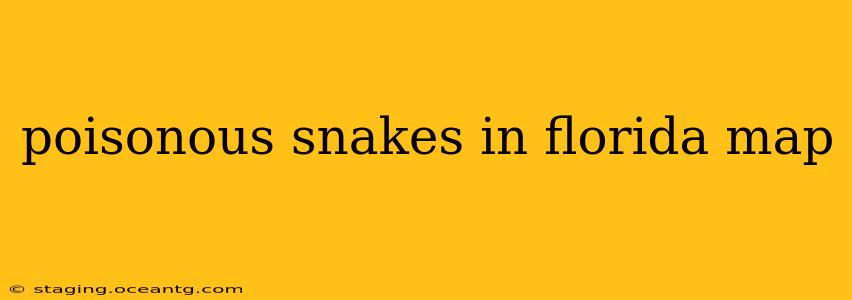Florida's diverse ecosystem boasts a fascinating array of wildlife, but it also harbors several venomous snake species. Understanding which snakes are dangerous and where they're found is crucial for safety, especially for those living in or visiting the Sunshine State. This comprehensive guide will equip you with the knowledge to identify poisonous snakes in Florida and navigate the state with increased awareness. We'll also address some frequently asked questions surrounding this important topic.
Disclaimer: This information is for educational purposes only. Do not attempt to handle any snake you suspect is venomous. If bitten, seek immediate medical attention.
Identifying Poisonous Snakes in Florida
Florida is home to six venomous snake species belonging to the Viperidae and Elapidae families:
- Eastern Diamondback Rattlesnake ( Crotalus adamanteus): Easily recognizable by its large size, diamond-shaped markings, and rattling tail. This is the largest venomous snake in North America.
- Canebrake Rattlesnake (Crotalus horridus): Smaller than the Eastern Diamondback, with darker, more defined markings. Often found near water sources.
- Timber Rattlesnake (Crotalus horridus): Similar to the Canebrake, but with a more variable pattern. Often found in upland areas. Note: The Canebrake and Timber Rattlesnakes are sometimes considered the same species, with variations based on location.
- Copperhead (Agkistrodon contortrix): Distinguished by its copper-colored head and hourglass-shaped markings along its body. Often found in wooded areas.
- Cottonmouth (Agkistrodon piscivorus): Also known as a water moccasin, this snake is typically found near water and has a dark, almost black, body with a broad, dark band across its head.
- Coral Snake (Micrurus fulvius): A small, brightly colored snake with distinct red, yellow, and black bands. Its venom is potent neurotoxin. Remember the rhyme: "Red on yellow, kill a fellow; red on black, venom lack." However, this rhyme isn't foolproof for all coral snake species, so caution is always advised.
Where are Poisonous Snakes Found in Florida? (Map Needed Here - Unfortunately, I cannot create a visual map. Consider using an online map tool like Google Maps to search for "Venomous Snake Habitats Florida" for visual aids. Many wildlife websites and organizations will also offer range maps for these species.)
While a precise map showing the exact location of every venomous snake is impossible, understanding their preferred habitats is key to minimizing encounters:
- Rattlesnakes: These snakes prefer dry, upland areas with rocky outcrops, pine forests, and scrublands. They're often found near water sources, especially during dry periods.
- Copperheads: These snakes prefer wooded areas, rocky hillsides, and areas with dense underbrush.
- Cottonmouths: As their name suggests, these snakes prefer swamps, marshes, and other aquatic habitats.
- Coral Snakes: These snakes can be found in a variety of habitats, including sandy pine forests and flatwoods.
What to Do if You Encounter a Venomous Snake?
The best course of action is always to avoid contact. Give the snake plenty of space, and do not attempt to handle it.
- Maintain a safe distance: Slowly back away from the snake, keeping your eyes on it. Avoid sudden movements that might startle it.
- Alert others: If you are with others, warn them to stay away.
- Seek medical attention: If bitten, immediately seek medical attention. Try to remember the snake's characteristics to help with identification.
Frequently Asked Questions (PAA)
(Note: I've had to infer PAA questions, as access to real-time search engine data is limited. The questions below are representative of likely user queries.)
What is the most dangerous snake in Florida?
The Eastern Diamondback Rattlesnake is generally considered the most dangerous due to its large size, potent venom, and aggressive nature. However, all venomous snakes in Florida pose a serious threat, and any bite requires immediate medical attention.
How common are venomous snake bites in Florida?
While venomous snake bites occur, they are relatively rare. The vast majority of people living in Florida never experience a snake bite.
Are all snakes in Florida venomous?
No. Florida has a significant number of non-venomous snake species. Many are beneficial to the ecosystem, controlling rodent populations.
What should I do if I find a venomous snake on my property?
Contact a licensed wildlife removal professional to safely relocate the snake. Never attempt to handle the snake yourself.
What time of year are venomous snakes most active in Florida?
Venomous snakes are generally more active during warmer months, from spring through fall. However, they can be encountered throughout the year, particularly in milder climates.
Are there any antivenom treatments available for Florida venomous snake bites?
Yes, antivenom is available for all venomous snake species found in Florida. Emergency medical personnel are trained to administer it as needed.
This guide provides a general overview of poisonous snakes in Florida. Remember, responsible behavior and preventative measures are the best ways to ensure safety while enjoying Florida's natural beauty. Always prioritize safety and seek professional help when encountering or bitten by a venomous snake.
